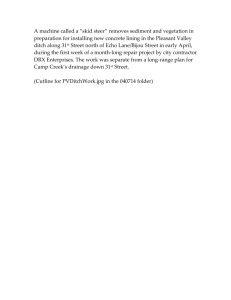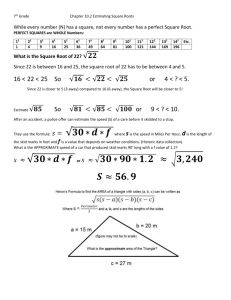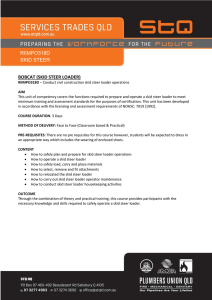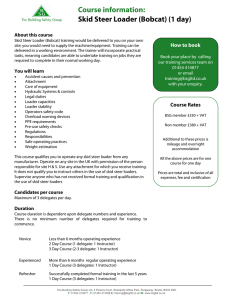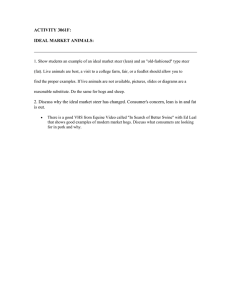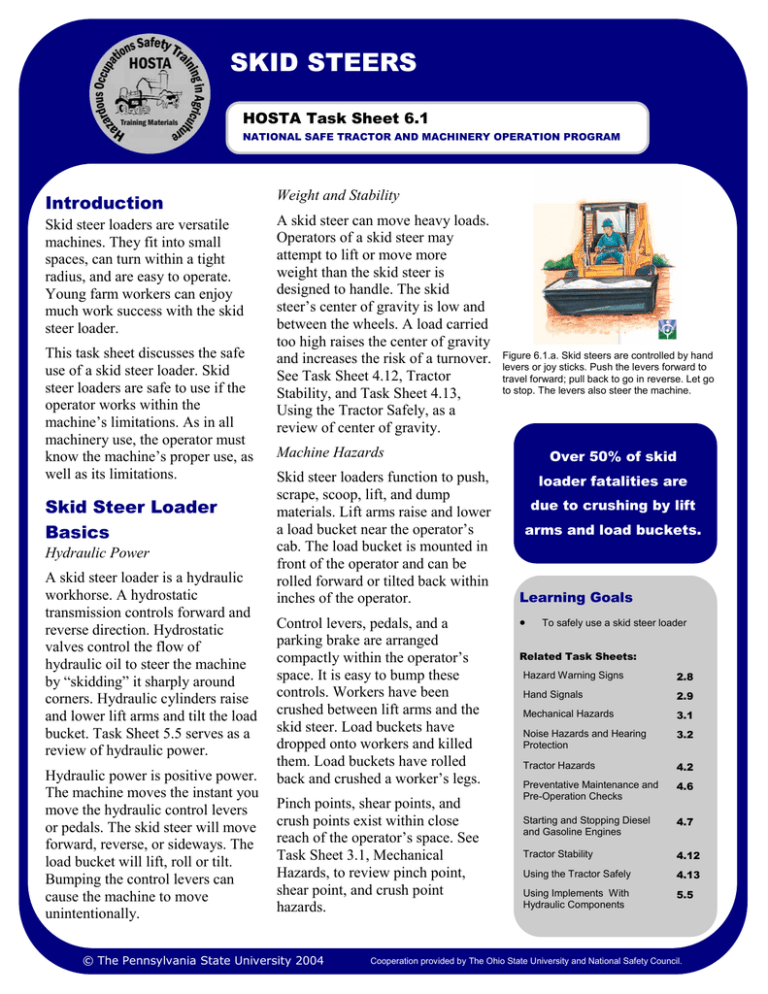
SKID STEERS
HOSTA Task Sheet 6.1
NATIONAL SAFE TRACTOR AND MACHINERY OPERATION PROGRAM
Introduction
Weight and Stability
Skid steer loaders are versatile
machines. They fit into small
spaces, can turn within a tight
radius, and are easy to operate.
Young farm workers can enjoy
much work success with the skid
steer loader.
A skid steer can move heavy loads.
Operators of a skid steer may
attempt to lift or move more
weight than the skid steer is
designed to handle. The skid
steer’s center of gravity is low and
between the wheels. A load carried
too high raises the center of gravity
and increases the risk of a turnover.
See Task Sheet 4.12, Tractor
Stability, and Task Sheet 4.13,
Using the Tractor Safely, as a
review of center of gravity.
This task sheet discusses the safe
use of a skid steer loader. Skid
steer loaders are safe to use if the
operator works within the
machine’s limitations. As in all
machinery use, the operator must
know the machine’s proper use, as
well as its limitations.
Skid Steer Loader
Basics
Hydraulic Power
A skid steer loader is a hydraulic
workhorse. A hydrostatic
transmission controls forward and
reverse direction. Hydrostatic
valves control the flow of
hydraulic oil to steer the machine
by “skidding” it sharply around
corners. Hydraulic cylinders raise
and lower lift arms and tilt the load
bucket. Task Sheet 5.5 serves as a
review of hydraulic power.
Hydraulic power is positive power.
The machine moves the instant you
move the hydraulic control levers
or pedals. The skid steer will move
forward, reverse, or sideways. The
load bucket will lift, roll or tilt.
Bumping the control levers can
cause the machine to move
unintentionally.
Figure 6.1.a. Skid steers are controlled by hand
levers or joy sticks. Push the levers forward to
travel forward; pull back to go in reverse. Let go
to stop. The levers also steer the machine.
Over 50% of skid
Machine Hazards
Skid steer loaders function to push,
scrape, scoop, lift, and dump
materials. Lift arms raise and lower
a load bucket near the operator’s
cab. The load bucket is mounted in
front of the operator and can be
rolled forward or tilted back within
inches of the operator.
Control levers, pedals, and a
parking brake are arranged
compactly within the operator’s
space. It is easy to bump these
controls. Workers have been
crushed between lift arms and the
skid steer. Load buckets have
dropped onto workers and killed
them. Load buckets have rolled
back and crushed a worker’s legs.
Pinch points, shear points, and
crush points exist within close
reach of the operator’s space. See
Task Sheet 3.1, Mechanical
Hazards, to review pinch point,
shear point, and crush point
hazards.
© The Pennsylvania State University 2004
loader fatalities are
due to crushing by lift
arms and load buckets.
Learning Goals
•
To safely use a skid steer loader
Related Task Sheets:
Hazard Warning Signs
2.8
Hand Signals
2.9
Mechanical Hazards
3.1
Noise Hazards and Hearing
Protection
3.2
Tractor Hazards
4.2
Preventative Maintenance and
Pre-Operation Checks
4.6
Starting and Stopping Diesel
and Gasoline Engines
4.7
Tractor Stability
4.12
Using the Tractor Safely
4.13
Using Implements With
Hydraulic Components
5.5
Cooperation provided by The Ohio State University and National Safety Council.
Page 2
SKID STEERS
Use both
Right Foot Control Pedal
Left Foot Control Pedal
hands and
both feet to
control the
skid steer’s
work.
Operating the Skid
Steer Loader
Preventative maintenance
Before using the skid steer,
complete a maintenance inspection
of the machine. Check the oil level,
tire pressure, coolant level, and
fuel. See Task Sheet 4.6 to review
similar items to check on a tractor.
Entering and exiting the skid steer
Before entering the machine,
observe the following points.
•
•
Lift arms and bucket should be
completely lowered. Do not
reach into the cab from the
ground level to move hydraulic
levers or pedals to position the
lift arms and bucket. Crushing
can result.
The seat and floor should be
clear of obstructions. Objects
can roll beneath foot control
pedals and interfere with the
machine’s operation.
To enter the skid steer, use the grab
Figure 6.1.b. The hands and feet control the skid steer. Foot controls raise the lift arms
(boom) and tilt or roll the bucket. The left heel raises the lift arms. The left toes lowers
the lift arms. The right heel rolls the bucket back to load. The right toes tilt the bucket
to dump the contents of the bucket. Practice these actions before proceeding to
operate the skid steer.
bars (hand holds) and the tread
plates mounted on the load bucket.
A three-point hold provides the
safest footing. The load bucket and
machine surfaces can be slippery
when wet or muddy. Exit from the
machine in the same manner.
When seated, lower the restraint
bar and/or fasten the seat belt
immediately.
Controls
Before using the skid steer,
become familiar with the controls.
A qualified person should
demonstrate how to start and stop
the engine, how to move the
machine forward and reverse, how
to steer the skid steer, and how to
raise, lower, and tilt the bucket
attachment. It is a good idea to
know how to safely change
attachments. If an attachment to
the skid steer uses hydraulic
power, ask for a demonstration of
how to engage the remote
hydraulic unit.
understand the following points:
•
Movement controls: Grasp the
right and left hand control
levers; push both levers
forward to move forward, or
pull the levers rearward to
move in reverse. Let go of the
levers to stop the movement.
•
Steering controls: To control
the steering direction, push one
hand lever forward while
pulling the other lever back.
Pushing the left lever forward
while pulling the right lever
back will make the skid steer
travel to the right.
•
Lift controls: Foot pedals
control the lift arms and load
bucket. The left pedal raises
and lowers the lift arms, while
the right foot pedal tilts the
bucket to dump or rolls the
bucket back. See Figure 7.1.b.
and page 3 for more details.
Skid steer loaders are controlled by
hand levers and foot pedals. The
beginning operator should
© The Pennsylvania State University 2004
Cooperation provided by The Ohio State University and National Safety Council.
Page 3
HOSTA TASK SHEET 6.1
Using the Lift Arm and
Load Bucket Pedals
Foot pedals on the skid steer are
used to control the high lift (boom)
work of the skid steer. Toe and
heel movements are needed to
activate these controls. See Figure
7.1.b. Note: Some models use the
hand controls to make these
movements.
•
•
•
•
Raising the lift arms (left pedal):
The left pedal raises or lowers the
lift arm (boom). Use the left heel to
push on the back of the pedal to
raise the lift arms and bucket. Use
the left toes to push on the front of
the pedal to lower the bucket.
These movements must be done
smoothly. Hard-soled shoes give
better feel for the pressure needed
on the pedal.
•
•
•
•
Tilting the bucket (right pedal):
The right pedal controls the load
bucket. Use the right heel to push
on the back of the pedal to roll the
bucket back while loading. Use the
right toes to push on the front of
the pedal to dump the bucket while
unloading.
•
•
•
Skid Steer Safety
Skid steer loaders can work in
small areas, but they have similar
limitations as does a tractor.
Follow these skid steer safety
recommendations:
• One seat and one seat belt
means one operator. No passengers are permitted on the
bucket.
• Lower the safety restraint bar
and/or fasten the seat belt every
time you enter the machine.
• Be sure area around skid steer
is clear of children,
•
bystanders, pets, and farm
animals
Do not work near overhead
utility lines.
Lower the load bucket for
travel.
Use slower speeds over rough
ground
Do not overload the bucket.
Skid steers have a Rated
Operating Capacity. Exceeding
that capacity with a lifted load
will result in forward or
sideways tipping of the
machine. See Figure 7.1.c.
When moving up a slope, keep
the heaviest weight up the hill.
With an empty bucket, back up
the hill. With a full bucket,
drive forward up the hill. See
Figure 7.1.d.
Avoid crossing steep slopes.
Avoid ditches and stream
banks to prevent overturns.
Lower the boom and bucket,
stop the engine, and set the
park brake before dismounting
the machine. Do this every
time.
Never stand or lean where lift
arms or load bucket
movements could crush you.
Use the lift arm locks (boom
locks) to prevent lift arms from
dropping downward if repairs
must be made to the machine.
Prevent load rollback by
securing loads in the bucket
and filling the bucket only to
rated levels.
Do not reach outside of the cab
while the skid loader is
running. All adjustments and
connections of attachments
should be made with the engine
stopped.
Figure 6.1.c. Skid steer loaders can tip forward
if overloaded. This is an important reason to
wear the seat belt, as well as understand the
skid loader’s load limitations.
Some skid
steer models
use hand
controls to
raise and lower
the lift arms
and to tilt the
load bucket.
Safe skid steer loader work
requires attention to the machine,
the surroundings, and the work
being done.
© The Pennsylvania State University 2004
Figure 6.1.d. With no load in the bucket,
the safest practice is to back up a steep
slope. With a loaded bucket, drive up a
steep slope with the bucket lowered.
Cooperation provided by The Ohio State University and National Safety Council.
Page 4
SKID STEERS
Safety Activities
1. Use the Internet to visit manufacturers’ websites (John Deere, New Holland, Bobcat, etc). Assemble a
picture chart of as many skid steer loader attachments as you can find.
2. Set up a skid steer loader course to practice moving the skid steer around and through obstacles. Be sure that
one part of the obstacle course involves using the load bucket.
3. With adult supervision and a blind fold (skid steer parked and brakes locked), raise and lower the lift
(boom) arms and tilt and roll the bucket as the supervisor commands you. You must be able to use the
proper controls to operate the skid steer without errors.
4. Matching. Match the skid steer control position with the resulting action to be expected.
Skid steer control position
Resulting action to be expected
_____A. Left foot pedal pushed forward with toes
1. Skid steer spins in circles to the left
_____B. Left foot pedal pushed downward with heel
2. Lift arm raises
_____C. Right foot pedal pushed forward with toes
3. Bucket tilts forward to unload
_____D. Right foot pedal pushed downward with heel
4. Bucket rolls back to load
_____E. Right hand control lever pushed fully forward,
left hand control lever pulled fully back
5. Lift arm lowers
_____F. Right hand control lever pulled backward,
left hand control lever pulled back
6. Skid steer moves forward
7. Skid steer moves in reverse
References
1. Safety Management for Landscapers, GroundsCare Businesses, and Golf Courses, 2001, First
Edition, John Deere Publishing, Moline, Illinois.
2. www.cdc.gov/niosh/nasd/Click on search by
topic/Scroll to Skid Steer.
3. www.cdc.gov/niosh/At search box, type
Preventing Injuries and Deaths from Skid Steer
Loaders.
Contact Information
National Safe Tractor and Machinery Operation Program
The Pennsylvania State University
Agricultural and Biological Engineering Department
246 Agricultural Engineering Building
University Park, PA 16802
Phone: 814-865-7685
Fax: 814-863-1031
Email: NSTMOP@psu.edu
Credits
Developed, written and edited by WC Harshman, AM Yoder, JW Hilton and D J Murphy,
The Pennsylvania State University. Reviewed by TL Bean and D Jepsen, The Ohio State
University and S Steel, National Safety Council.
Version 4/2004
This material is based upon work supported by the Cooperative State Research, Education, and Extension
Service, U.S. Department of Agriculture, under Agreement No. 2001-41521-01263. Any opinions, findings,
conclusions, or recommendations expressed in this publication are those of the author(s) and do not
necessarily reflect the view of the U.S. Department of Agriculture.
© The Pennsylvania State University 2004
Cooperation provided by The Ohio State University and National Safety Council.
ATVS AND UTILITY VEHICLES
HOSTA Task Sheet 6.2
NATIONAL SAFE TRACTOR AND MACHINERY OPERATION PROGRAM
Introduction
They look like fun. They can go
fast. They can travel in the woods.
They can kill and injure. What are
they? They are ATVs and utility
vehicles.
In a recent year, 90,000 injuries
and 120 deaths were reported due
to use of these fun vehicles. The
U.S. Consumer Product Safety
Commission reports that 4 of every
10 people treated in hospital
emergency rooms are younger than
age 16. Why would this be the
case?
This task sheet discusses safe use
of ATVs and utility vehicles as
they are used for work and
recreational purposes.
All-Terrain Vehicles
As the name implies, all-terrain
vehicles (ATVs) can travel almost
anywhere. Rough terrain, steep
slopes, rutted mountain roads, and
muddy conditions make ATV use
appealing. Sportsmen, leisure time
enthusiasts, and workers use
ATVs. ATVs have become a
valuable tool for farm and ranch
tasks.
ATVs are designed for work. Other
task sheets discuss tractor and skid
steer stability. Review Task Sheets
4.12, 4.13, and 7.1. Then consider
these ATV design features.
• stability
• suspension
•
•
drive lines
power and speed
Stability: A four-wheel ATV is
more stable than a three-wheel
ATV. Heavy loads, steep slopes,
and “popping the clutch” can cause
the ATV to roll or flip backward.
Overturns occur with operator
actions that change the center of
gravity.
Note: Three-wheeler sales have
been banned for several years.
Figure 6.2. a. A four-wheeler, or ATV, can be
used for many purposes. Respect the ATV for
the powerful machine it is.
Suspension: ATV suspension
systems vary with the machine.
Less expensive models may use
only balloon tires for suspension.
These ATVs can bounce and pitch
sideways at high speeds. More
expensive models use coil springs
and shock absorbers to improve
traction and steering control.
Drive lines: ATV drive
mechanisms vary greatly. Several
combinations of clutches,
driveshafts, and differential locks
are used. Higher speeds and sharp
turns can increase the risk of side
overturns if the drive wheels are
locked together for traction.
Power and Speed: ATV engines
vary in size from 100 cc to 700 cc.
Transmission gear ratios vary also.
Some ATVs can travel over 50
mph. High-speed operation of the
ATV increases the risk of loss of
control and rollovers.
Remember, ATVs are not toys.
They are powerful machines.
© The Pennsylvania State University 2004
It is good advice to
dispose of a threewheeler ATV. They
turn over easily.
Learning Goals
•
To safely use ATVs and utility
vehicles for work and recreational
purposes
Related Task Sheets:
Injuries Involving Youth
2.1
Age-Appropriate Tasks
2.4
Mechanical Hazards
3.1
Tractor Hazards
4.2
Tractor Stability
4.12
Using the Tractor Safely
4.13
Skid Steers
7.1
Cooperation provided by The Ohio State University and National Safety Council.
Page 2
ATVS AND UTILITY VEHICLES
Injury from
ATV use most
often occurs
because of:
A) extra
passengers
B) excessive
speed
C) road travel
Figure 6.2.b. ATV use as a farm tool calls for strength to control the machine, skill to
move and direct the machine, and maturity to understand the consequences of unsafe
ATV use. An adult supervisor should work with you to help you learn how to work
safely with an ATV.
ATV Operation
and Safety
Safety training for ATV use is the
first step in being a qualified ATV
operator. Local ATV dealers, ATV
clubs, and safety professionals
from Cooperative Extension and
farm organizations may offer safe
ATV operation programs. The
Specialty Vehicle Institute of
America (SVIA) provides training
as well. Visit them on the Internet
at www.svia.org. At a minimum,
use the operator’s manual and the
safety signs on the ATV to help
educate yourself before using the
machine.
maturity determine readiness to
operate an ATV.
•
•
•
Here are some guidelines for safe
ATV use:
•
Manufacturers recommend that
ATVs with engine sizes greater
than 70cc be sold only for
children 12 and older and that
ATVs with engines greater
than 90cc be sold only for
individuals 16 and older. The
child’s strength, skills, and
•
Carrying passengers increases
the risk of overturn injury and
death. A second person
changes the center of gravity of
the machine and the machine’s
steering ability.
Know the machine’s
limitations. Operating on steep
terrain, pulling heavy loads,
excessive speed, and “wheelie”
type starts can result in ATV
turnover.
Wear a full-face shield helmet.
The helmet should fit snugly
and securely. It should be
labeled with the American
National Standards Institute
(ANSI) Z90.1 label.
If a face shield is not part of
the helmet, wear goggles or a
separate face shield, especially
at high speeds or in wooded
terrain. The protective lens
should carry the ANSI Z78.1
© The Pennsylvania State University 2004
label.
•
Over-the-ankle shoes with
sturdy heels and soles are
necessary.
•
Gloves and long sleeves are
needed for specific jobs.
•
Use lights, reflectors, and
highly visible flags to increase
the ATV’s visibility.
•
Avoid public roads. Paved and
unpaved roads are designed for
truck and automotive traffic.
ATVs are designed for off-road
use. Increased risk for rollovers
of ATVs on road surfaces has
been shown.
•
Check your state’s vehicle code
for use of the ATV as an
agricultural machine. Use of
the ATV for agricultural
purposes and only incidental
road travel may be permitted in
your state.
Cooperation provided by The Ohio State University and National Safety Council.
Page 3
HOSTA TASK SHEET 6.2
a utility vehicle.
Utility Vehicles
Utility vehicles are similar to golf
carts except they are fitted with
cargo boxes to carry work material.
The utility vehicle can have four,
five, or six wheels depending upon
its use. The UV weighs about
1,000 pounds and can carry
several hundred pounds of cargo.
The machine can be diesel,
gasoline, electric, or hydrogen fuel
cell powered.
•
With increased amounts of
cargo, the utility vehicle’s
center of gravity is raised. Risk
of an overturn increases. Drive
slowly and turn smoothly.
•
To prevent overturns, secure
the load from shifting
sideways.
•
Avoid driving on steep slopes.
It is safer to drive uphill or
downhill rather than across a
slope. Avoid sharp turns to
prevent overturns. Drive to the
top or bottom of a slope to
make a turn. When
approaching a downhill slope,
reduce speed before you reach
the slope. This will help reduce
wear on the brakes.
Like other farm machines, the
utility vehicle is made for work
purposes. Hauling feed, mulch
materials, and supplies makes it a
convenient transport for small jobs.
Like an ATV, the utility vehicle is
a tool and not a toy.
Safe operation of the utility vehicle
requires the same safe work habits
as used with tractors, skid steer
loaders, and ATVs.
•
•
A second rider should occupy
the passenger seat. Do not permit extra riders to ride in the
cargo box. Use the handholds.
If the utility vehicle has a rollbar, buckle the seat belt.
•
Do not drive near ditches or
embankments. Remember if
the ditch is 6 feet deep, stay
back from the edge by at least
6 feet.
•
Use your tractor, skid steer
loader, and ATV knowledge to
safely operate a utility vehicle.
Safe Utility Vehicle Use
Use the operator’s manual and
safety signs/decals found on the
machine to learn how the utility
vehicle operates and what safety
practices to observe. A successful
operator becomes familiar with a
machine before attempting to use
it. Ask a qualified operator to show
you what to do if no training
materials can be found.
The following safety practices
should be followed in operating a
utility vehicle:
•
Some manufacturer’s
specifications suggest that no
operator younger than age 16
should be permitted to operate
Reduce speed over rough
terrain to prevent the utility
vehicle from bouncing.
Operator and riders have been
thrown from utility vehicles.
As with all machinery, use the
device as it was designed. Utility
vehicles are tools, not toys.
© The Pennsylvania State University 2004
Figure 6.2.c. A utility vehicle is versatile. It can
do the smaller jobs that a pick-up truck may be
unsuited to do. Remember that the utility vehicle
has limitations. Overloading, shifting loads, and
sharp braking can cause turnovers.
Utility vehicles
can overturn at
high speeds
and while
making sharp
turns.
Figure 6.2.d. Avoid steep banks. Utility
vehicles can easily overturn. The driver
must know the machine and the work
area to reduce potential risk of injury.
Safety Management for Landscapers, Grounds-Care
Businesses, and Golf Courses, John Deere Publishing,
2001. Illustrations reproduced by permission. All rights
reserved.
Cooperation provided by The Ohio State University and National Safety Council.
Page 4
ATVS AND UTILITY VEHICLES
Safety Activities
1. Use the Internet website www.atvsafety.org to solve crossword puzzles or to play word search games
related to all-terrain vehicle (ATV) safety.
2. Visit the John Deere website, www.JohnDeere.com, or the Bobcat website, www.bobcat.com, to learn about
all-terrain vehicle (ATV) specifications for weight, payload, and engine size.
3. Collect newspaper, magazine, or Internet news articles about ATV and utility vehicle injuries and deaths.
Create a poster presentation to display at a local ATV or utility vehicle dealership.
4. What does the designation “100cc engine” represent? Using the math formula for volume of a cylinder (ask
your teacher), calculate the diameter and height of the cylinder that would represent a 100cc engine
cylinder. Use a sheet of paper to construct the cylinder. Answer the same question for a 500cc engine
cylinder.
References
1.
Safety Management for Landscapers, Grounds-Care
Businesses, and Golf Courses, John Deere Publishing,
2001. Illustrations reproduced by permission. All rights
reserved.
2.
www.cdc.gov/nasd/ Search the National Ag Safety
Database site by topic for ATV information.
3. www.atvsafety.org/Search site for interactive
quizzes, word searches, and puzzles.
4. www.svia.org/Search the Specialty Vehicle
Institute of America site for ATV information.
© The Pennsylvania State University 2004
Contact Information
National Safe Tractor and Machinery Operation Program
The Pennsylvania State University
Agricultural and Biological Engineering Department
246 Agricultural Engineering Building
University Park, PA 16802
Phone: 814-865-7685
Fax: 814-863-1031
Email: NSTMOP@psu.edu
Credits
Developed, written and edited by WC Harshman, AM Yoder, JW Hilton and D J Murphy,
The Pennsylvania State University. Reviewed by TL Bean and D Jepsen, The Ohio State
University and S Steel, National Safety Council.
Version 4/2004
This material is based upon work supported by the Cooperative State Research, Education, and Extension
Service, U.S. Department of Agriculture, under Agreement No. 2001-41521-01263. Any opinions, findings,
conclusions, or recommendations expressed in this publication are those of the author(s) and do not
necessarily reflect the view of the U.S. Department of Agriculture.
Cooperation provided by The Ohio State University and National Safety Council.

